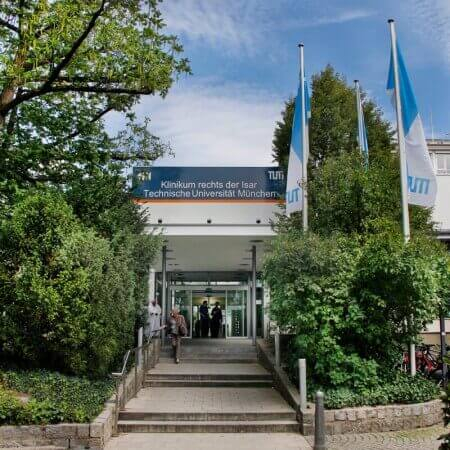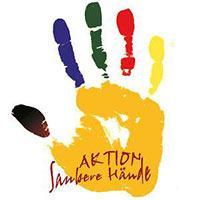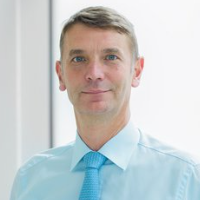Cervical Cancer — Embolization or Chemoembolization: treatment in the Best Hospitals in the World
Treatment prices are regulated by national law of the corresponding countries, but can also include additional hospital coefficients. In order to receive the individual cost calculation, please send us the request and medical records.

Department of Interventional Radiology
The Department of Interventional Radiology offers the full range of imaging examinations, as well as innovative image-guided minimally invasive techniques for the treatment of tumors, vascular diseases and internal pathologies (for example, CT, MRI, PET-CT, SPECT). The department's doctors have deep knowledge and colossal experience in the field of interventional radiological methods of treatment, which represent an excellent alternative to open surgical interventions. Despite the high level of technical equipment and the presence of advanced computerized systems, the focus is always on the person with his individual needs. Compliance with current clinical protocols and high professionalism of the department's specialists contribute to the successful clinical practice, as well as the reputability of the department among the best medical facilities of this kind in Germany.




Department of Interventional Radiology and Neuroradiology
The Department of Interventional Radiology and Neuroradiology offers a full range of advanced imaging diagnostics and minimally invasive treatments on both an inpatient and outpatient basis. The department has state-of-the-art medical equipment for imaging tests such as X-ray, computed tomography, magnetic resonance imaging, digital subtraction angiography, and mammography. The medical facility also performs many highly effective interventional therapeutic procedures under image guidance, which in many cases allow patients to avoid traumatic open surgery. For example, the department successfully performs local fibrinolysis, thrombectomy, percutaneous transluminal angioplasty, hemostasis, transarterial chemoembolization, uterine artery embolization, and other procedures. The department's neuroradiologists specialize in brain and spinal cord imaging and the treatment of central nervous system disorders. Interventional neuroradiology focuses on the treatment of carotid artery stenosis, brain aneurysms, arteriovenous malformations, dural fistulas, subdural hematomas, brain tumors, skull base and spinal tumors, and chronic back pain. The department's medical team has extensive clinical experience in their areas of expertise. The specialists are guided by the recommendations of the German Society for Interventional Radiology and Minimally Invasive Therapy (DeGIR) and the German Society for Neuroradiology (DGNR), which helps to achieve the best results.






Department of Adult and Pediatric Diagnostic, Interventional Radiology, Neuroradiology
The Department of Adult and Pediatric Diagnostic, Interventional Radiology, Neuroradiology is one of the best institutions of its kind in Germany and offers patients the full range of radiological studies and imaging-guided minimally invasive therapy. The department’s scope of tasks also includes imaging diagnostics in children of all age groups, detection and invasive treatment of cerebral vascular pathology (neuroradiology). Patient care is provided both on an inpatient and outpatient basis.






Cervical cancer is the most common malignant tumor of the reproductive system in young women. Its development is caused by human papillomavirus. In developed countries, the disease becomes less common and is usually cured at the early stages. However, in countries with a poor level of medicine, cervical cancer is often detected at the advanced stages, and therefore it requires combination treatment. Doctors abroad use not only standard treatment methods, but also carry out uterine artery chemoembolization. The procedure can be used before surgery to remove the uterus or as an independent method of local control of the tumor.
Content
- What is embolization
- In what cases can embolization be used for cervical cancer
- How is the procedure performed
- Embolization results
- Benefits of chemoembolization
- Why is it worth undergoing chemoembolization abroad
- Treatment in Europe with Booking Health at an affordable price
What is embolization
Embolization is a treatment method in oncology, which involves closing the lumen of the vessels supplying the tumor. Due to a lack of blood supply, cancer cells die, so the tumor decreases in size.
Embolization has been used in oncology since the 1970s. Uterine artery embolization was first performed in 1979 to stop bleeding after childbirth. Since the end of the twentieth century, it has been used in the treatment of uterine fibroids. Since the beginning of the 21st century, the procedure has been increasingly used for cervical cancer.
There are various agents used for the closure of the lumen of the vessels. These include:
- Polyurethane foam particles.
- Hemostatic sponge.
- Microspheres.
- Metal spirals.
- Alcohols.
- Adhesive compositions.
- Blood clots, etc.
In its classical form, embolization is usually used to eliminate uterine bleeding, which occurs at the advanced stages of cervical cancer.
Nonetheless, the treatment is usually aimed at increasing life expectancy or reducing the tumor size for its follow-up surgical removal. Therefore, embolization is usually supplemented with regional chemotherapy. In this form, the procedure is called chemoembolization. This treatment option is very effective, as it allows the doctors to create a high concentration of cytostatics in the tumor tissue.
In what cases can embolization be used for cervical cancer
Cervical cancer is well treated at the early stages, but patients with locally advanced stages are not candidates for radical surgery. Surgery is actually the only method, which can provide a complete cure for the disease.
With unresectable cancer, the task of doctors is to reduce the tumor size and make it resectable. The cancer can be subsequently removed by trying to cure the disease. To reduce the size of the neoplasm, neoadjuvant treatment, most often chemotherapy, is used. It opens the possibility of using a surgical method for some patients.
Not all patients respond to chemotherapy. In some of them, the disease is manifested by severe uterine bleeding, which causes anemia and worsens a general health condition of the woman. In such cases, uterine artery embolization is used.
The procedure is combined with regional chemotherapy, which is more effective than systemic chemotherapy due to the higher concentration of the active substance in the tumor focus. The drug load on cancer cells increases by 1.5 times, while the number and severity of systemic side effects decreases. In 2005, the clinical efficacy advantage of regional chemotherapy over systemic chemotherapy was first proved in a randomized trial (O. Ikeda et al.).
Thus, the goals of using uterine artery embolization for cervical cancer are as follows:
- Tumor size reduction.
- Increased likelihood of achieving a resectable state in order to further remove the tumor surgically and try to cure cervical cancer.
- With an inoperable tumor, local control of the disease, increasing the duration and quality of a woman's life.
- Cessation of uterine bleeding.
How is the procedure performed
The treatment options for cervical cancer using embolization or chemoembolization are attractive to many patients as the procedures are safe for health and minimally invasive. The doctor obtains access to the uterine arteries through the vessels in the leg. Other access options are less commonly used – through the brachial, axillary, and radial arteries.
The most important stage of the procedure is diagnostics. Doctors perform angiography to assess the type of blood supply to the reproductive organs and cancer. An inadequate assessment of angioarchitectonics (structure of the vascular network) leads both to a decreased effectiveness of the procedure and to an increased risk of complications in the organs adjacent to the uterus.
The doctor injects drug-eluting microspheres into the arteries, which feed the tumor. They clog blood vessels and for a long time release chemotherapy drugs, which destroy cancer cells.
Postembolization syndrome may persist for 2-3 days after the procedure. It is manifested by abdominal pain, nausea, and fever. Painkillers and anti-inflammatory drugs are used to relieve symptoms.
Embolization results
Uterine bleeding completely stops within 1 week after the procedure.
The uterus decreases in size gradually. The maximum results can be achieved after 3 weeks. This period is optimal for further treatment – surgery or radiation therapy according to a radical program.
The best results can be achieved with the exophytic nature of tumor growth, namely when it grows into the lumen of the reproductive organs. In general, the prognosis for this form of pathology is worse. After chemoembolization, the volume of the uterus in such patients decreases 3-4 times.
Benefits of chemoembolization
As compared to other treatment options for cervical cancer, uterine artery chemoembolization has many advantages:
- Minimally invasive method. After the procedure, a patient does not need to recover for a long time. The duration of a hospital stay is 3-4 days.
- Higher efficiency as compared to systemic cytostatic therapy, since the concentration of chemotherapy drugs in the tumor is one and a half times higher with less systemic toxicity.
- There is a high likelihood of achieving tumor resectability: it can be removed surgically a few weeks after chemoembolization.
- Embolization can be combined with virtually any treatment for cervical cancer.
- Suitable treatment for patients who are weakened due to disease or have concomitant diseases.
- In addition to the tumor reduction, the procedure stops uterine bleeding.
Why is it worth undergoing chemoembolization abroad
European oncology hospitals have been successfully using various options for uterine artery chemoembolization in the treatment of cervical cancer for more than 20 years. The technique of performing this procedure is constantly improved, which makes it more effective and safe.
There are several reasons why you should undergo uterine artery embolization treatment in Europe:
- Vast experience in the use of uterine artery chemoembolization for the treatment of cervical cancer.
- High-precision diagnostics allows the doctors to carry out accurate assessment of the state of the vasculature in order to perfectly plan the X-ray-guided surgical treatment of cancer.
- Doctors protect non-target vessels from penetration of embolization agents into them in order to avoid complications associated with ischemia (insufficient blood supply) of organs adjacent to the uterus.
- New types of chemoembolization are used for the treatment of cancer, including the use of drug-eluting microspheres.
- Doctors abroad successfully combine embolization with other cancer treatment options: surgery, radiation therapy, systemic drug therapy.
Treatment in Europe with Booking Health at an affordable price
To undergo treatment in one of the European hospitals, please use the services of Booking Health. On our website, you can see the cost of treatment in different European hospitals, compare prices and book a medical care program at an affordable price. Transcatheter chemoembolization for cervical carcinoma in European hospitals will be easier and faster for you, and the cost of treatment will be lower.
Please leave your request on our website. Our employee will contact you and provide consultation about the treatment in Europe. Booking Health will take care of the organization of your trip. We will provide the following benefits for you:
- We will select a hospital for treatment in Europe, whose doctors specialize in transcatheter chemoembolization for cervical carcinoma.
- We will help you overcome the language barrier, establish communication with your attending physician.
- We will reduce the waiting period for the medical care program and book a doctor's appointment on the most suitable dates.
- We will reduce the price. The cost of treatment in European hospitals will be lower due to the lack of coefficients for foreign patients.
- We will take care of all organizational issues: documents for entering the country, transfer from the airport, hotel, interpreting services, etc.
- We will prepare a medical care program and translate medical records. You do not have to undergo previously performed diagnostic procedures.
- We will provide communication with the hospital after treatment in Europe.
- We will organize additional diagnostic examinations and treatment in European hospitals, if necessary.
- We will buy medicines abroad and forward them to your native country.
- We will help you keep in touch with the hospital and the doctor after treatment in Europe.
You will receive treatment from the best doctors in the world. The Booking Health specialists will help reduce the cost of treatment and take care of all organizational issues, and you will only have to focus on restoring your health.
Authors: Dr. Nadezhda Ivanisova, Dr. Sergey Pashchenko

